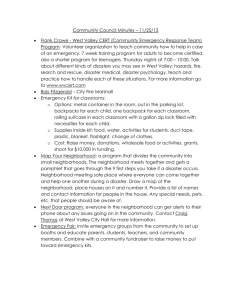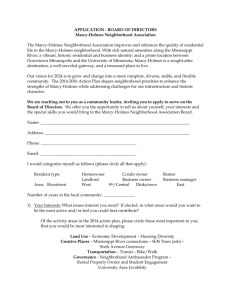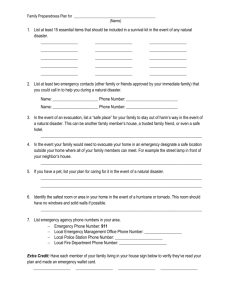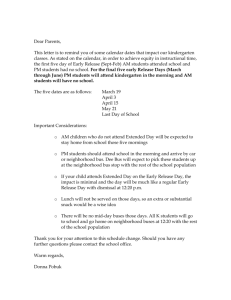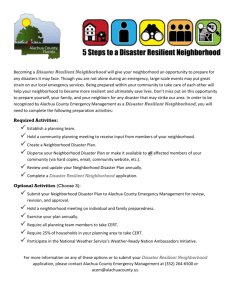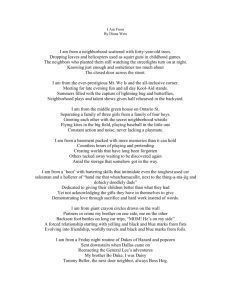a.4 neighborhood care center annex
advertisement
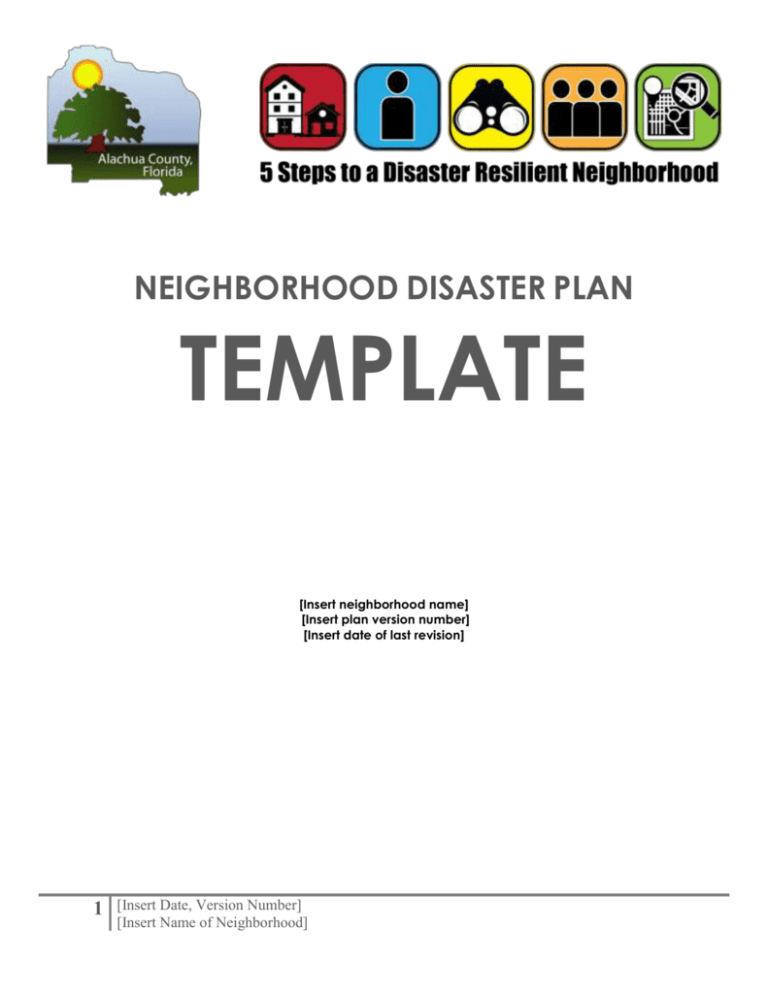
NEIGHBORHOOD DISASTER PLAN TEMPLATE [Insert neighborhood name] [Insert plan version number] [Insert date of last revision] 1 [Insert Date, Version Number] [Insert Name of Neighborhood] Resources for this program adapted from the City of Los Angeles Emergency Management Department’s “You can build a NEIGHBORHOOD DISASTER PLAN in just 5 steps.” Many thanks to this department for sharing their resources. 2 [Insert Date, Version Number] [Insert Name of Neighborhood] TEMPLATE INSTRUCTIONS This Neighborhood Disaster Plan Template is meant to serve as a framework for planners to build or refine a disaster plan for their neighborhood. This helpful resource provides direction [in brackets] where you can add neighborhood specific information. This template is a simple tool that may be used in conjunction with 5 Steps to a Disaster Resilient Neighborhood, a resource that contains details regarding the type of information that should be included in a neighborhood disaster plan. 5 Steps to a Disaster Resilient Neighborhood, as well as other supplemental resources, can be accessed through Alachua County Emergency Management at neighborhoods.alachuacounty.us or by calling (352) 264-6500. 3 [Insert Date, Version Number] [Insert Name of Neighborhood] PLAN MAINTENANCE PLAN MAINTENANCE AND UPDATE __________________________________ is responsible for maintenance and update of the plan. The plan will be updated annually and in response to lessons learned from exercises or actual disasters. The contact person for plan updates is __________________________________. PLAN DISTRIBUTION Printed copies of the initial plan and future updates will be distributed to all residences of the plan coverage area. The plan will also be posted on the _______________________________ website. PLAN MODIFICATION REGISTER Changes made to the plan are reflected below. DESCRIPTION OF CHANGE 4 PAGE NUMBER [Insert Date, Version Number] [Insert Name of Neighborhood] DATE OF CHANGE AUTHORIZED SIGNATURE ACKNOWLEDGMENTS [Include information regarding the people, agencies, and organizations that were involved in the development of your neighborhood disaster plan.] This plan was developed by members of the (Name neighborhood association and/or other group/s): __________________________________________ __________________________________________ The following people participated in development of the plan (List Name & Organization): ____________________________________ ______________________________ ____________________________________ ______________________________ ____________________________________ (Name) ______________________________ (Organization) The plan was completed on: __________________________________ (Date) ________________________________________________________ (Signature of Chair or Leader of plan development team) 5 [Insert Date, Version Number] [Insert Name of Neighborhood] TABLE OF CONTENTS [Insert a table of contents once the plan is complete.] 6 [Insert Date, Version Number] [Insert Name of Neighborhood] 1. INTRODUCTION 1.1 BACKGROUND As community members, we recognize that preparing for disasters is not a luxury, but an imperative. Disasters are not a matter of “if”, but “when”, and Alachua County is no exception, with its susceptibility to hurricanes, tornadoes, floods, and wildfires, among other natural and man-made hazards. [Insert information about the area covered by the plan, the locations of the nearest fire station, police station, and hospital, and any other local features significant to planning.] 1.2 PURPOSE The primary purpose of the plan is to outline strategies that our neighborhood members can take to support ourselves in the event of a disaster. It is meant to cover large-scale disasters as well as smaller emergencies. The plan is based on the recognition that the priorities in a disaster are self, family, and neighbors. It is built on the concept of neighbors helping neighbors until outside help arrives. We hope that this plan will provide a mechanism for our neighborhood to sustain itself until city or county services and outside support is obtained. 1.3 HOW THE PLAN WAS DEVELOPED [Discuss how the plan was developed (e.g. through a series of meetings), when it was developed, who it was developed by (general descriptions of those who worked on it or specific names), and who led the project.] 1.4 ABOUT OUR NEIGHBORHOOD [Insert specific descriptive information about your neighborhood, to include its location in Alachua County, the general addresses or blocks of the area, square mileage, the date the neighborhood was founded, the number of homes covered by the plan, the number of people residing in the neighborhood, its ethnic and cultural makeup, languages commonly spoken, and any community centers or significant landmarks.] 7 [Insert Date, Version Number] [Insert Name of Neighborhood] 1.5 ORGANIZATION OF THE PLAN This plan is organized into three parts: The Basic Plan identifies threats and risks to the neighborhood, lists neighborhood assets, and outlines a community disaster response strategy. The basic plan applies to all hazards. Functional Annexes detail how specific tasks, such as Communications or Search and Rescue, will be performed. Hazard Specific Annexes describe responses to specific hazards, such as floods or hurricanes. 8 [Insert Date, Version Number] [Insert Name of Neighborhood] 2. BASIC PLAN Refer to 5 Steps to a Disaster Resilient Neighborhood for guidance and tips for filling out this template. STEP 1 – DEFINE YOUR AREA (See page 3 of the Disaster Resilient Neighborhood Guide) The scope of our plan includes ___________________________. [Describe the geographic area covered by the plan using street names or other easily-understood features. If you are building a plan for units of a multi-story building, list the floors and unit ranges. Make a map or sketch of the area that can be updated or added to later.] STEP 2 – RECRUIT LEADERS AND PARTICIPANTS (See page 4 of the Disaster Resilient Neighborhood Guide) Make a list of people in your neighborhood that have skills or experience that would be useful in developing a plan. Name 9 Skill or Experience [Insert Date, Version Number] [Insert Name of Neighborhood] Address and Telephone STEP 3 – SCOUT YOUR NEIGHBORHOOD Threats and Risks (See page 5 of the Disaster Resilient Neighborhood Guide) The threats and risks that our neighborhood is most susceptible to are listed here in order of likelihood. [Include information that you prepared as part of the Threats and Risks section in step 3 of 5 Steps to a Disaster Resilient Neighborhood. List threats and risks by likelihood of occurrence.] THREAT LIKELIHOOD OF OCCURRENCE1 LEVEL OF IMPACT2 Almost Certain: Greater than 90% chance Likely: 50 – 90% chance Moderate: 10 – 50% chance Unlikely: 3 – 10% chance Rare: 3% chance or less 2 Minor: Some disruption of services possible. Little or no property damage, personal injury, or loss of life Moderate: Disruption of some services. Minimum property damage, injury, and loss of life Major: Many services disrupted and/or structures severely damaged. Multiple injuries and significant loss of life Catastrophic: Disruption of most or all services. Widespread property damage. Many Injuries and fatalities 1 10 [Insert Date, Version Number] [Insert Name of Neighborhood] Key Assets (See page 8 of the Disaster Resilient Neighborhood Guide) Identify the assets in your community that would help to respond to or recover from a disaster. Our neighborhood assets are: [Include information that you prepared as part of the Neighborhood Assets section in step 3 of 5 Steps to a Disaster Resilient Neighborhood.] ASSET TYPE ASSET DESCRIPTION ASSET LOCATION OR CONTACT INFORMATION3 Make a Map (See page 10 of the Disaster Resilient Neighborhood Guide) [Add detail to the map of your area prepared in Step 1 to include things like a Neighborhood Gathering Place, Triage area, and other important information that can be easily displayed.] Due to confidentiality concerns, names and contact information for skilled personnel are not published but are maintained by CERT Leaders and Block Captains. 3 11 [Insert Date, Version Number] [Insert Name of Neighborhood] STEP 4 – BUILD YOUR TEAM (See pages 12 of the Disaster Resilient Neighborhood Guide) [Using the list of people with special skills and experience you identified in Step 1 or others you may have identified in Step 3 as Neighborhood Assets, build teams that can help the neighborhood prepare for disasters and respond effectively if a disaster strikes. Using the organization chart on page 15 of the Disaster Resilient Neighborhood Guide, determine who might fill which of the roles depicted on the chart. Be sure to identify alternates in case the primary person is unavailable.] STEP 5 – PLAN YOUR STRATEGY (See pages 19 of the Disaster Resilient Neighborhood Guide) [Detail how your neighborhood will respond. Write it down.] Individual and Family Disaster Response Actions. Discuss the responsibilities of individuals and families in disaster response. Make sure to emphasize that the priority is to ensure the safety of individuals, families, pets, property, and neighbors. Consider discussing such things as: The need to check for unsafe conditions, such as downed power lines and gas leaks; The procedure for shutting off all valves that are not automatic; The importance of tuning into emergency radio frequencies to obtain information and instructions; The importance of the proper use of protective gear, such as a hard hat or bicycle helmet, steel-toe or other sturdy shoes, and leather or sturdy gloves. [Optional] After ensuring the safety of each household member households should place the OK/Help hanger on their front door or window so that it can easily be seen from the sidewalk or street. The red side means that help is needed; the green side means that everyone is OK. It is for use only after a disaster when 9-1-1 help is unavailable. [Use of the door hangers is optional depending on your community’s decision to distribute and utilize them. A substitute method may be used if it would be preferred by your community.] Families should lock their doors, secure their belongings, and proceed to the Neighborhood Gathering Place. Neighborhood Response. Once the neighborhood has gathered at the designated Neighborhood Gathering Place, the first task is to assess who is present and who is absent. Then, the preselected leader, or their replacement, will begin to direct the overall effort. An Action Plan will be developed to help the neighborhood decide what to do, how to do it, and what timeframe to do it in. Finally, the neighborhood should organize into teams, with a Team Leader or Block Captain for each team. Each team should have 3-7 people and the Team Leader or Block Captain. 12 [List the communications systems you plan to use. For radios, be sure to list the frequencies. Designate one person to collect all radios once response efforts have concluded.] [Prepare a notification chart and “call down” procedures, as shown in the Notification Annex on the following pages. There should be a “master” notification chart to make sure the identified leaders are notified and each Block Captain should develop and [Insert Date, Version Number] [Insert Name of Neighborhood] 13 maintain a notification chart for residents in his/her area. Email addresses should be included as well.] [Create a list of capabilities needed for each area of response and designate people to fill those roles. For example, the Triage and Treatment area will need people who are trained in first aid. Roles should be reviewed and confirmed at every other neighborhood meeting to accommodate for new people and to maintain preparedness for disasters.] [List Key Locations:] Our Neighborhood Gathering Place is: [Include primary and alternate] Our Neighborhood Care Center is: [Include primary and alternate] Our Triage Area is: [Include primary and alternate] [List Key Personnel. Include primary and alternates for each position and 24/7 contact information:] Our Incident Commander is: Our Block Captains are: Our Communications leader is: Our Mass Care leader is: Our Materials and Supplies leader is: Our Search and Rescue leader is: Our Transportation leader is: [Include the Incident Command System flow chart for your neighborhood, if you choose to use this system of organization. (You can learn more about the Incident Command System by taking FEMA’s Independent Study Course 100: Introduction to Incident Command System found at training.fema.gov.)] [Determine which Support Annexes and Hazard Specific plans should be prepared and added to the basic plan in the future (see pages 19 of the Disaster Resilient Neighborhood Guide).] [Describe how your neighborhood will maintain your plan and document special considerations in the planning process. Include specific training and exercise recommendations (e.g., types of training/exercise events, frequency, etc.).] [Describe the way that you will share this plan (e.g., distribute door to door, post on website, etc.).] [Insert Date, Version Number] [Insert Name of Neighborhood] FUNCTIONAL ANNEXES [These annexes focus on specific responsibilities, tasks, and actions. Early identification of the functions that are critical to successful emergency response is an extremely important planning task. Each core function becomes a separate annex.] [Planners should ensure that specific concerns of population segments, such as children, individuals with limited accessibility, and those with functional needs, are addressed.] [Include information that you prepared as part of the “Put It in Writing” (step 5.3) of 5 Steps to a Disaster Resilient Neighborhood. Consider functions such as Communications, Search and Rescue, Animal Care, Triage and Treatment, and Neighborhood Care Center. A few examples of functional annexes are provided on the following pages. Your Functional Annex section will likely be much longer.] 14 [Insert Date, Version Number] [Insert Name of Neighborhood] A.1 NEIGHBOR SURVEY A.1.1 SUMMARY OF SURVEY RESULTS [Summarize the results of the Neighborhood Survey that was distributed and collected from neighborhood residents. This Survey is part of the Toolkit that contains the Disaster Resilient Neighborhood Guide and other documents.] 15 [Insert Date, Version Number] [Insert Name of Neighborhood] A.2 COMMUNICATION ANNEX A.2.1 PURPOSE The purpose of this annex is to outline the methods that will be used to notify community members of a disaster. A.2.2 NOTIFICATION PROCEDURE [Detail the chain of communication, who should be contacted at each designated level, and the method and alternate method(s) of contact, such as phone, radio, and/or door-to-door contact. Do not forget to include your local fire-rescue station and Alachua County Emergency Management. Determine who will contact these entities and be sure to include them in your phone tree diagram.] [Consider the following:] 1. The person at the top will start the notification process. It may be helpful to have a brief script prepared with space available for event specific information. 2. Ask the contacted person to write down the specific information rather than conveying the information from memory. 3. Give facts about the event. 4. Be sure to have alternative phone numbers and radio frequencies, in order to reach someone who is out of the home or office. 5. If no one answers, leave a message and try using the alternate method of contact. If contact is still not made, contact the rest of your list, as well as those assigned to the person who did not answer. This should ensure that everyone gets the information in a timely fashion. 6. Confirm they will be making contact with the next person(s) on the chart. 7. Prearrange with individuals at the end of the list to contact the person at the top once they receive the message. The LAST person on the notification chart should CONTACT THE FIRST person to ensure that the chart is completed and that the message was accurate. [Consider providing a list of phone numbers and radio frequencies in this Annex. Phone numbers should be updated regularly and call-downs should be exercised regularly.] 16 [Insert Date, Version Number] [Insert Name of Neighborhood] A.3 SEARCH AND RESCUE ANNEX A.3.1 PURPOSE The purpose of this annex is to detail procedures that will be followed once it is determined that there is a need to perform a search and rescue mission in the area following a disaster or emergency incident. A.3.2 GENERAL PROCEDURES Search and Rescue is actually two separate activities. During the Search phase, the team systematically inspects the area for victims. In the Rescue phase, the team aims to free victims from confinement. The objectives of Search and Rescue include: Maintain rescuer safety Rescue the greatest number of people in the shortest amount of time Rescue the lightly trapped victims first [If the neighborhood has members trained in CERT, the CERT teams will be responsible for initiating Search and Rescue procedures and assigning teams to specific areas.] Key strategies and themes include: Designate rescuer safety as a priority Be alert for hazards Wear safety equipment (hard hats, goggles, sturdy shoes) Never enter an unstable structure Following a disaster or during an emergency, the CERT team or other designated leaders will assemble at the Neighborhood Gathering Place and designate Search and Rescue teams. A member of each Search & Rescue team should be assigned to ensure that animals are rescued and cared for. Consider assigning a designated recorder to each Search and Rescue team to ensure that the proper forms are completed and all important information is documented. Simple steps for conducting a Search: Check for red or green door tags [or whatever markers were predetermined by your neighborhood]. Red tags mean that residents are requesting assistance. Use the lists of “persons needing assistance” created by the neighborhood. Conduct an initial damage assessment to identify hazard areas and prioritize Search & Rescue operations. Search & Rescue teams should notify victims they pass during the damage assessment that they will return to rescue them. Call out. Begin by shouting "If you can hear my voice, come out!" Be systematic. Use a search pattern to ensure that all areas of a building are covered. For example, start searching on the bottom floor and work up, or move from the right to left across a house. Listen carefully. Stop frequently and listen for voices or tapping sounds. Use the buddy system. Work together -- two rescuers can search a structure more effectively and safely. 17 [Insert Date, Version Number] [Insert Name of Neighborhood] Mark searched areas. Make a single diagonal slash on or next to the door just before entering. Make an opposite slash (creating an "X") when all occupants have been removed and the search of that area is finished. [Examples of the CERT “X” are included here. This system is widely recognized and would be beneficial for your teams to use.] Example: Example: Date Time In Time Out Name or ID of person/search team Areas Searched Victims 9/9/2014 In: 1430 Out: 1515 Search and Rescue Team 2 Floors 1-2 searched, Stairs to Floor 3 unsafe 2 living, injured Moved to Triage Center Document results. Keep records of removed victims and victims who remain trapped. Effective rescue operations have three functions: (1) create a safe rescue environment, (2) triage and stabilize victims, and (3) remove victims to a safe rescue zone. Simple steps for conducting a Rescue: Gather necessary tools and equipment. This can be anything that will be helpful to move debris and large objects. Remove debris and lift objects out of the way. Wear gloves to protect your hands. Remove victims. Some will be able to move on their own once the path is cleared. Others will need assistance. The following procedures should be followed regarding deceased victims: Deceased victims found in residences should be left undisturbed. The number of deceased victims and their locations should be marked on the front entry. These numbers and the victim’s identifying information, if possible, should be recorded by the morgue team. Deceased victims found elsewhere should not be moved. Their location and identifying information, if possible, should be recorded by the morgue team. The morgue team should give their records to emergency personnel and/or the medical examiner upon their arrival in the neighborhood. 18 [Insert Date, Version Number] [Insert Name of Neighborhood] A.4 NEIGHBORHOOD CARE CENTER ANNEX A.4.1 PURPOSE The purpose of this annex is to detail procedures for the activation and operation of a Neighborhood Care Center. Definition A Neighborhood Care Center is a neighborhood location established during or after a disaster where children, older adults, persons with disabilities and other functional needs, and others needing non-clinical care can be provided a safe, secure environment to receive care. Location Criteria While it is understood that emergencies create an imperfect environment, emergency response leadership should choose the Care Center location with the following general criteria in mind: The Care Center should be physically separated from areas housing the general population. Since electricity and HV/AC systems may not be operable following an emergency, Care Center locations should have natural light and ventilation. Locations should meet Americans with Disabilities Act (ADA) access requirements and have the capacity to accommodate access and functional needs populations. If possible, children should be separated from adults (other than their family members) when receiving care. Neighborhoods should strive to create a safe atmosphere within the Care Center to promote relationship building. Staffing Criteria Care Centers should ideally be staffed with trained professionals. However, in a disaster situation, centers will be staffed with available personnel. In selecting persons for staffing centers, leadership should consider the following: Use the list of personnel assets from CERT leaders and Block Captains to identify persons with experience in child care, older adult care, and care for persons with disabilities and other functional needs. If trained/experienced personnel are not available, select persons who are known in the neighborhood. Assign at least one person to provide constant supervision to the children’s area and at least one person to the adult area. Two supervisors at a time is always preferable when possible. If a supervisor needs to take a break, another person must be temporarily assigned to fill his/her role. Constant supervision is imperative. Assign observers with no care responsibilities to observe operations and report any concerns or issues. Designate one entry/exit for the center and designate someone to provide security for it. A display board should be situated near the entry/exit that lists names of those who are within the center to provide timely information to relatives who may be looking for their loved ones. Consider assigning someone with a mental health or psychology background to the Care Center to provide support services to those within. 19 [Insert Date, Version Number] [Insert Name of Neighborhood] Assign a liaison to communicate information between the Command Post and the Care Center regarding the status of victims. 20 [Insert Date, Version Number] [Insert Name of Neighborhood] HAZARD AND THREAT ANNEXES [The contents of hazard- or threat-specific annexes focus on the special planning needs generated by each specific situation. Include information that you prepared as part of the “Put It in Writing” section in step 5 of 5 Steps to a Disaster Resilient Neighborhood. Consider hazards such as power outages, wildfires, floods, hurricanes, tornadoes, and any other hazards that threaten your community.] 21 [Insert Date, Version Number] [Insert Name of Neighborhood]
